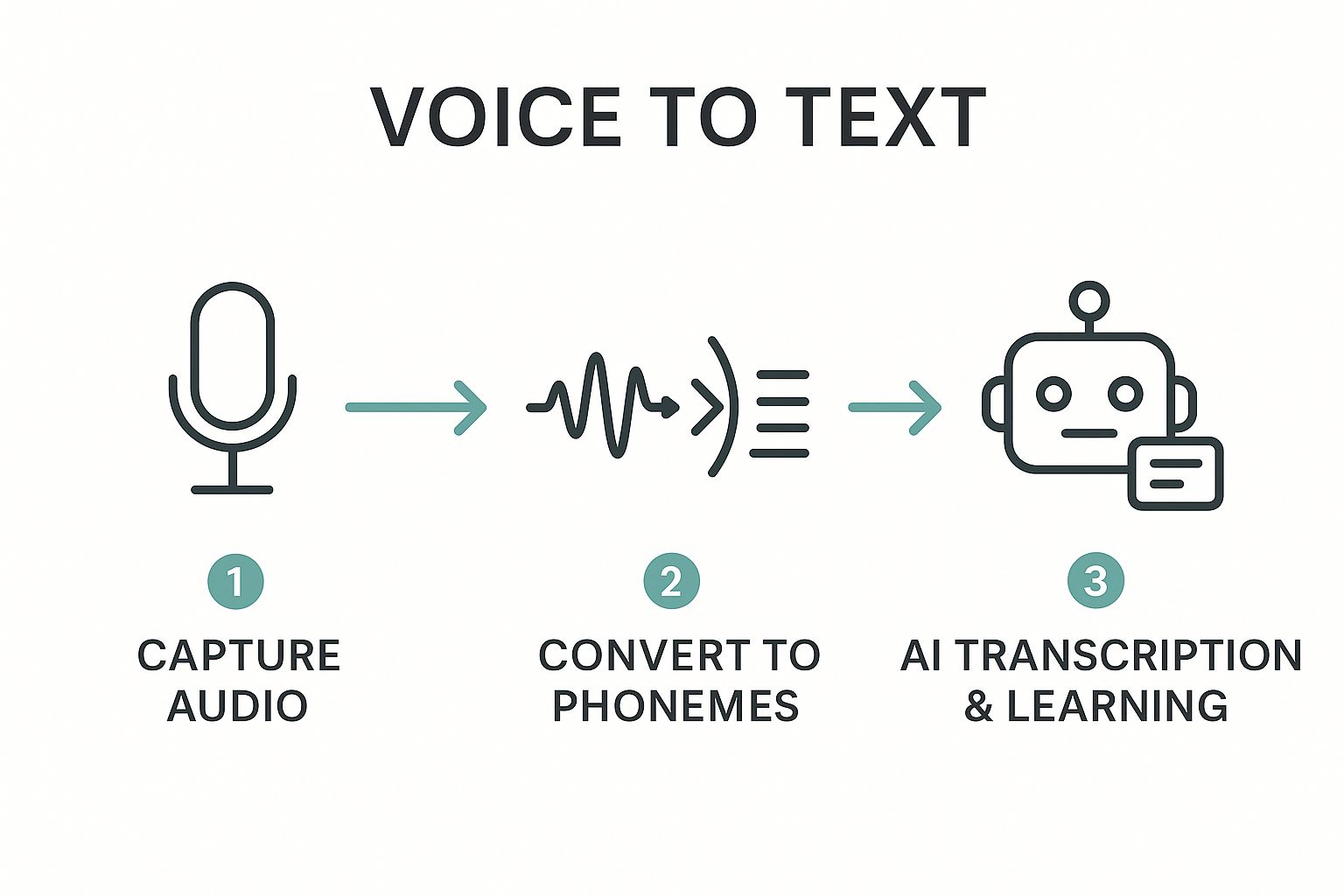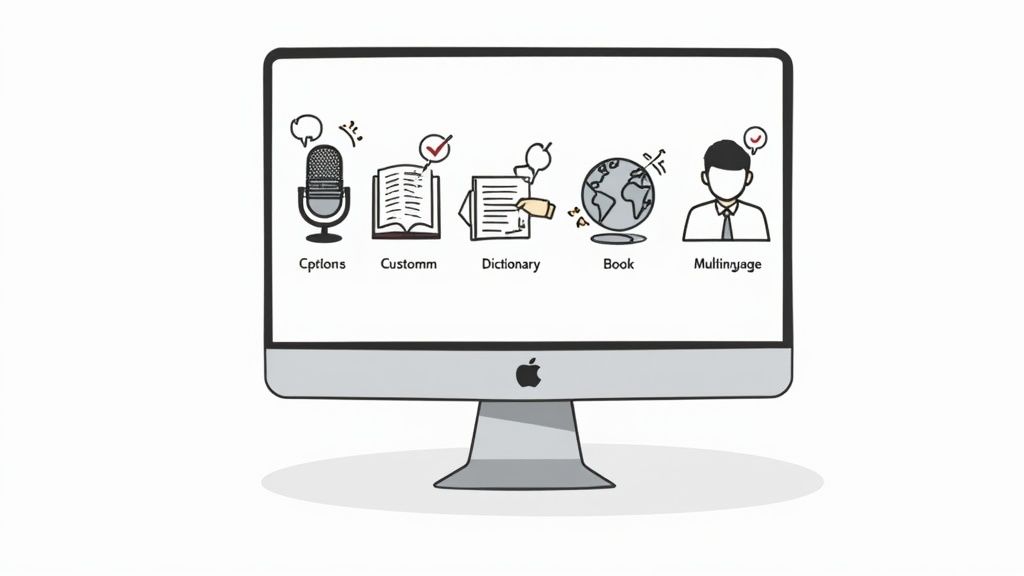Your Guide to Voice to Text Software Online
Discover how voice to text software online can transform your productivity. Learn how it works, find essential features, and choose the best tool for you.
Oct 11, 2025

What if you could draft reports, clear your inbox, or get that article written three times faster, just by talking? That's not science fiction; it's the reality of using voice to text software online. This guide will walk you through how this incredible tech works and how it can give you back hours of your week.
The End of Endless Typing

Does the very idea of tackling a long document or a mountain of emails make your fingers ache? You're definitely not alone. Typing is a necessary skill, but let's be honest—it can be a real bottleneck, slowing down the journey from a great idea in your head to a finished piece of writing. It’s often slow, repetitive, and a major drain on your creative energy.
This is where speaking your thoughts directly onto the page changes everything. Imagine completely bypassing the keyboard. Instead of the clumsy process of translating thoughts from your brain to your fingertips, you can just... talk. The words flow naturally, letting you capture ideas the moment they spark.
Reclaiming Your Most Valuable Asset: Time
The first thing you'll notice when using voice to text software online is the incredible speed. Most of us speak at around 150 words per minute, but the average person types at a sluggish 40 words per minute. That’s not a small difference. We're talking about a complete change in your workflow, allowing you to get things done more than three times faster.
Think about what that extra time means for your day. It creates a ripple effect.
Less Time on Admin Drudgery: Firing off emails, taking meeting notes, and sending messages becomes quick and painless, freeing you up for the work that really matters.
Faster Creative Output: If you're a writer or creator, this is a total game-changer. You can find helpful advice on how to overcome writer's block and just let your ideas pour out without the stop-and-start of typing.
A Lifeline for Accessibility: For anyone with physical disabilities or conditions like carpal tunnel, dictation software is more than a convenience—it's an essential tool for communication.
Modern dictation software is about more than just raw speed. It's about creating a workflow that feels more natural and less constrained. It removes the physical barrier of the keyboard, creating a more direct line between your thoughts and the written word.
In this guide, we’ll dive into how this tech works, check out all the different ways you can use it, and help you pick the perfect tool. We'll be using MurmurType as our main example because it's a fantastic showcase of what modern dictation can do—blending top-notch accuracy, solid privacy, and a simple, clean interface.
Get ready to say goodbye to the slow grind of typing and hello to a smarter, faster, and more creative way to work.
How Your Voice Becomes Text
Ever talk to your phone and wonder how it just gets what you're saying? It feels like a bit of everyday magic, but what's happening behind the screen is a really cool mix of acoustics, linguistics, and some seriously smart AI. At its heart, voice to text software online is like a digital translator, but instead of swapping languages, it turns the sound waves from your voice into words on a screen.
It all starts the second you make a sound. The software’s first job is to grab that audio through a microphone and digitize it, turning the analog sound waves of your voice into a format a computer can actually work with. Think of it as taking a photograph of a sound.
From Sound Waves to Building Blocks
Once your voice is in the system, the software starts to pick it apart. It doesn't listen for whole words right away. Instead, it breaks your speech down into the smallest units of sound that differentiate one word from another, known as phonemes.
For example, the word "cat" has three phonemes: the "k" sound, the "a" sound, and the "t" sound. The software is trained to identify these fundamental pieces in the audio, essentially creating a phonetic map of whatever you just said.
This infographic gives you a quick visual of that journey from spoken word to digital text.

As you can see, it goes from simple audio capture to some pretty complex AI interpretation, which is where the real magic happens.
The AI's Role in Understanding You
This is where the brains of the operation, an Automatic Speech Recognition (ASR) engine, jumps in. This AI model has been fed a massive diet of data—we're talking thousands upon thousands of hours of speech from all kinds of people, with different accents, dialects, and languages.
The ASR engine then solves a complex probability puzzle. It takes the sequence of phonemes it detected from your voice and compares it against its vast library to find the most likely word or phrase. It’s smart enough to use context, grammar, and sentence structure to figure out if you said "I scream" or "ice cream." The process is a great example of AI interpreting different inputs, and if you want to geek out on the tech, you can learn more by understanding multimodal learning and AI's capabilities.
This technology has become so essential that its market has absolutely exploded. The global voice and speech recognition market was valued at USD 10.46 billion in 2018 and is on track to hit USD 31.8 billion by 2025. That incredible jump is all thanks to us using our voices to interact with everything from our phones and smart speakers to our cars.
The best systems don't just transcribe; they learn. Every correction you make and every new word you use helps refine the AI model, making it progressively more accurate and attuned to your specific way of speaking.
This ability to learn and adapt is what makes modern tools like MurmurType so incredibly useful. They get used to your personal vocabulary and speaking style over time. This is a huge help when you need to transcribe audio files full of jargon or unique names. Before you know it, the software becomes your own personalized transcription assistant, delivering accuracy that feels almost effortless.
Must-Have Features That Boost Productivity

As you start looking into voice to text software online, you’ll see pretty quickly that they aren't all created equal. Sure, the basic job is turning your spoken words into text, but the best tools are loaded with features that can genuinely supercharge how you work.
Think of it this way: any car can get you from point A to B. But the really great ones have built-in navigation, cruise control, and safety features that make the whole trip faster, easier, and just plain better. It's the same idea with dictation software—it’s the extra features that solve real-world problems and fit right into your daily grind.
Real-Time Transcription and Accuracy
One of the biggest non-negotiables is real-time transcription. This is where you see your words pop up on the screen the moment you say them. If you’re a journalist in an interview or a student trying to capture a lecture, this is huge. You get instant feedback, so you can spot a mistake right away or make sure you didn’t miss that one critical quote.
But speed means nothing without precision. High accuracy is the absolute foundation of a good dictation tool. The top software today can hit over 95% accuracy when you’re in a quiet spot. That level of reliability means you’re spending way less time fixing typos and more time focused on your actual work.
Custom Vocabulary and Language Support
Ever tried dictating a niche industry term only for the software to spit out some gibberish? That’s where a custom vocabulary feature becomes your best friend. It lets you teach the software your lingo—all the unique names, acronyms, and jargon you use every day.
Doctors and nurses can add complex medical terms.
Lawyers can input specific legal phrasing and case names.
Engineers and researchers can plug in all the technical terms specific to their field.
When you teach the software your language, the accuracy skyrockets, and those annoying corrections nearly disappear. On a similar note, support for multiple languages is a must for global teams or anyone who speaks more than one language. The best tools can flip between dozens of languages without missing a beat.
The big takeaway here? Customization isn't just a nice-to-have feature; it’s essential for productivity. The more a tool can bend to your specific needs, the more time and headache it will save you down the road.
Speaker Identification and Voice Commands
For anyone who has to transcribe meetings or group interviews, speaker identification is a total game-changer. Instead of getting one massive, confusing wall of text, the software automatically tags who said what. Just think of the hours you'll save on formatting meeting minutes or interview scripts.
Then you have voice commands, which add a whole new level of hands-free control. These are simple phrases like "new paragraph," "add a comma," or "bold that last sentence" that let you format your document as you speak. This keeps you in the creative flow, turning a simple dictation app into a full-blown writing assistant. It's an incredibly powerful way to speed up your document workflow automation. You can get the full scoop by reading our guide on how to automate your document workflow.
To give you an idea of how much voice tech is growing, just look at its sibling, text-to-speech (TTS), which does the reverse. The TTS market hit a value of USD 3.19 billion in 2024 and is expected to jump to USD 12.4 billion by 2033, largely because more people need accessibility tools. This boom shows a huge appetite for voice-based technology from every angle. If you're curious, you can dig into these insights on the text-to-speech market.
Real-World Uses for Voice-to-Text Software

The real magic of online voice-to-text software isn't just in the technology itself, but in how it solves everyday problems for actual people. It’s far more than a cool gadget; it’s a workhorse tool that professionals across all sorts of fields are using to work faster, stay organized, and avoid burnout.
Let's look at a few examples. I think the best way to understand the impact of this tech is to see how it completely changes the game for different people in their daily routines.
For the Overwhelmed Student
Picture this: you’re in a massive lecture hall, and the professor is talking a mile a minute. You're trying to furiously type every important point, but you can't keep up. You’re forced to choose between really listening or just frantically taking notes. It’s a classic dilemma that almost always ends with a jumbled, incomplete mess.
This is where voice-to-text software comes in. A student can just hit 'record' on their laptop or phone. The software transcribes the entire lecture as it happens, catching every single word. This simple act frees the student to actually listen, think about the concepts, and maybe even ask a question.
Problem Solved: The impossible task of typing as fast as a professor speaks.
The Outcome: You get complete, accurate, and searchable notes. That means better studying, less stress, and no more deciphering your own cryptic abbreviations.
For the Busy Legal Professional
A lawyer’s schedule is often a blur of court dates, client calls, and what feels like a never-ending mountain of paperwork. Carving out a quiet hour to draft a complex legal brief is a luxury they rarely have. Typing out every meticulous detail is slow and pulls their attention away from the high-level strategy that really matters.
This is where a tool like MurmurType can be a lifesaver. A lawyer can dictate detailed arguments, case notes, or client emails directly into a document in the spare moments between meetings. The software does all the typing, letting them get their thoughts down while they're still fresh—whether they’re at their desk or walking to the courthouse.
By taking the keyboard out of the picture, professionals can capture those fragmented bits of time throughout the day. A commute or a walk between appointments suddenly becomes a productive work session.
This turns document creation from a rigid, sit-down task into something much more fluid and continuous. It’s a powerful way to push back against the administrative overload that plagues so many demanding professions.
For the Creative Content Producer
If you’re a writer, podcaster, or YouTuber, you know that inspiration doesn't work on a 9-to-5 schedule. Ideas can pop into your head at the most random times, and staring at a blank screen can be paralyzing. The slow, deliberate act of typing can sometimes kill the natural flow of a creative idea.
Voice-to-text software lets creators draft content just by talking. You can brainstorm a blog post on a walk, outline a video script while making coffee, or capture a sudden thought for a podcast. In fact, one of the most common uses is creating transcripts for video, which is a breeze with dedicated YouTube transcription tools.
This "speak it first" approach is fantastic for getting raw ideas down fast. It helps you sidestep writer's block and produces a transcript that's ready for editing. You're capturing the real energy of an idea before it fades, leading to a much more natural and efficient creative process.
Of course! Here is the rewritten section with a more human, expert tone.
How to Pick the Right Voice-to-Text Tool for You
With so many voice-to-text software online options popping up, choosing one can feel a little overwhelming. On the surface, a lot of them look the same, but the devil is truly in the details. It’s those small differences that separate a genuinely helpful tool from a piece of software that just adds frustration to your day.
To find your perfect match, you need to look past the flashy marketing and focus on what will actually make a difference in your workflow. Think of it like test-driving a car—you wouldn’t buy one just because you like the color. You’d check under the hood, see how it handles, and make sure it’s safe. Let's do the same for dictation software.
Start with Transcription Accuracy
First things first: accuracy is everything. If the software is constantly bungling your words, you'll waste more time editing than you would have just typing it all out by hand. The best tools out there can hit accuracy rates over 95% in a quiet room, but the real question is how they perform in your world, with your voice and your background noise.
Don't just trust the numbers on a website—put it through its paces yourself. A good trial run should cover a few key things:
Your Accent and Speech: Just talk normally. Does the software keep up, or does it stumble over your particular dialect?
Your Professional Lingo: If you're in a specialized field like medicine or law, try dictating some jargon-heavy sentences. The top-tier tools, like MurmurType, let you add custom words to their dictionary, which is a game-changer for getting technical terms right.
Real-World Conditions: See how it handles a little bit of background noise. You’re not always going to be in a perfectly silent studio.
A tool’s accuracy is its foundation. If that’s shaky, none of the other features really matter.
Prioritize Simplicity and a Clean Interface
The best voice-to-text software online should feel like an old friend from the moment you open it. A clunky, confusing interface just gets in the way of what you’re trying to do, which is get your thoughts down quickly. The whole point is to make your life easier, not to give you another complicated program to learn.
A great user experience is almost invisible. The software should step aside and let you focus purely on what you want to say. Look for a clean design where you can find the record button without thinking and the settings are easy to understand.
The most powerful tools are the ones that blend so seamlessly into your workflow you forget they're even running. It should feel less like a piece of tech and more like a natural part of your thinking process.
For example, a tool like MurmurType is built to work inside any app on your Mac. That means no more copying and pasting from one window to another. You just dictate straight into your email, your document, or your notes. That kind of smooth integration is what a truly frictionless experience is all about.
Make Sure It Plays Well with Others
Your dictation software doesn’t live on an island. To be truly useful, it needs to connect effortlessly with the other apps you use all day, every day. Before you commit, jot down a quick list of your essential programs and check if the tool is compatible.
This might include things like:
Word processors (Microsoft Word, Google Docs)
Email clients (Outlook, Gmail)
Note-taking apps (Evernote, Apple Notes)
Team chat tools (Slack, Microsoft Teams)
When it integrates properly, you can dictate directly into these programs without skipping a beat. It keeps you in the zone and avoids the constant, jarring interruption of switching between apps.
Never, Ever Compromise on Security and Privacy
This last one might be the most important. When you’re dictating sensitive information—confidential client notes, private medical records, or your next big business idea—you have to be absolutely sure that your words are staying private.
Always take a minute to read the privacy policy. You're looking for clear, straightforward language about how your data is handled. Many services process your audio in the cloud, which has become common practice. In fact, this is part of a massive trend—the speech-to-text API market was valued at USD 3.81 billion in 2024 and is expected to hit USD 8.57 billion by 2030. You can see the full breakdown in this detailed market report on Grand View Research.
But for maximum peace of mind, look for tools that offer on-device processing. This means your voice data never leaves your computer, adding a critical layer of security. MurmurType, for instance, gives you the choice between local and cloud transcription. That kind of flexibility shows they respect your privacy and put you in control.
Got Questions? We've Got Answers
Diving into the world of voice-to-text software online can spark a few questions, especially if you're new to it. Let's walk through some of the most common ones I hear, so you can get started with confidence.
Just How Accurate Is This Stuff?
Today's voice-to-text software is incredibly good, often hitting over 95% accuracy when conditions are right. That means you're in a quiet spot with a decent microphone.
Of course, life isn't always ideal. Things like loud background noise, a cheap mic, or a very thick accent can knock that number down a bit. But the best tools are smart—they use AI that actually learns your unique voice and the words you use most often.
The big takeaway here is that accuracy isn't a fixed number. It's a living thing that gets better the more you use the software, quickly becoming a reliable partner for your daily work.
MurmurType, for example, even lets you add custom words to its vocabulary, which is a game-changer if you use a lot of technical terms or unique names.
Is It Safe to Dictate My Private Thoughts Online?
That's a great question, and one you should definitely be asking. Reputable companies take your privacy very seriously. Always look for a clear privacy policy that tells you exactly how they handle your data. Features like end-to-end encryption are a huge green flag.
If you're working with highly sensitive material, some tools offer on-device processing. This means your voice never even leaves your computer; it's transcribed right there. It’s the ultimate way to keep your data completely under your control.
Can It Understand Different Accents and Languages?
You bet. The leading platforms are built for a global audience from day one. Their AI models are trained on massive datasets filled with speech from all over the world, covering a huge range of languages, dialects, and accents.
This is what allows them to accurately capture what you're saying, whether you're from Boston or Brisbane. You'll usually find a list of supported languages right on the company's website, so you can quickly check if it’s a good fit for you.
What Gear Do I Need to Start?
You probably already have everything you need. Most voice-to-text software online works perfectly well with the microphone that’s already built into your laptop, tablet, or phone. For things like firing off emails or jotting down notes, it’s more than enough.
Now, if you're a professional who needs top-tier accuracy or you're often in a noisy place, investing in a simple external microphone can make a real difference.
USB Microphones: Just plug one into your computer for an instant and noticeable jump in audio quality.
Headsets with Mics: These are fantastic for busy offices or coffee shops. The mic sits close to your mouth, zeroing in on your voice and tuning out the chaos around you.